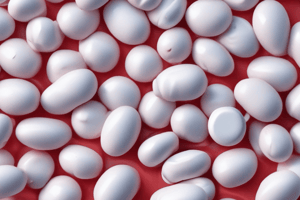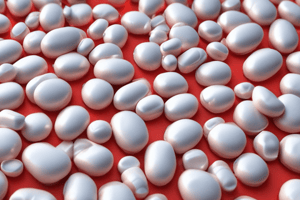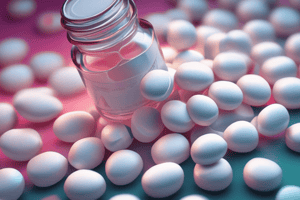Podcast
Questions and Answers
What is the primary use of aspirin in nonprescription treatment?
What is the primary use of aspirin in nonprescription treatment?
- Antibiotic
- Treatment of pain, inflammation, and fever (correct)
- Antidepressant
- Antiviral medication
Aspirin is stable in humid conditions.
Aspirin is stable in humid conditions.
False (B)
What products are created when aspirin hydrolyzes in contact with moisture?
What products are created when aspirin hydrolyzes in contact with moisture?
acetic acid and salicylic acids
The smell of acetylsalicylic acid is similar to ______ due to the hydrolysis yielding salicylic and acetic acid.
The smell of acetylsalicylic acid is similar to ______ due to the hydrolysis yielding salicylic and acetic acid.
Match the following properties/uses with the correct substance:
Match the following properties/uses with the correct substance:
What type of reaction is hydrolysis, in the context of esters in the content?
What type of reaction is hydrolysis, in the context of esters in the content?
Base hydrolysis of an ester produces a carboxylic acid and an alcohol directly.
Base hydrolysis of an ester produces a carboxylic acid and an alcohol directly.
In base hydrolysis, what type of base reacts with an ester?
In base hydrolysis, what type of base reacts with an ester?
Dr. Felix Hoffmann, working for Bayer, developed and patented a process for synthesizing ______ acid.
Dr. Felix Hoffmann, working for Bayer, developed and patented a process for synthesizing ______ acid.
In which year did Felix Hoffmann produce pure, stable acetylsalicylic acid?
In which year did Felix Hoffmann produce pure, stable acetylsalicylic acid?
The synthesis of aspirin involves reacting salicylic acid with an excess of sulfuric acid.
The synthesis of aspirin involves reacting salicylic acid with an excess of sulfuric acid.
From which plant family does salicylic acid originate?
From which plant family does salicylic acid originate?
In the procedure for synthesizing aspirin, a ______ is used to add acetic anhydride to salicylic acid.
In the procedure for synthesizing aspirin, a ______ is used to add acetic anhydride to salicylic acid.
What temperature is the water bath heated to when synthesizing aspirin?
What temperature is the water bath heated to when synthesizing aspirin?
Adding distilled water to the hot solution is not required in the aspirin synthesis procedure.
Adding distilled water to the hot solution is not required in the aspirin synthesis procedure.
What process is used to separate the synthesized aspirin crystals from the solution?
What process is used to separate the synthesized aspirin crystals from the solution?
The identification test for aspirin uses iron(III) chloride, also known as ______.
The identification test for aspirin uses iron(III) chloride, also known as ______.
Iron(III) chloride (FeCl3) reacts with what functional group to produce colored complexes in the identification test of aspirin?
Iron(III) chloride (FeCl3) reacts with what functional group to produce colored complexes in the identification test of aspirin?
To purify synthesized aspirin, one should warm the solution in ethanol to 100 °C.
To purify synthesized aspirin, one should warm the solution in ethanol to 100 °C.
In the calculation for percent yield, what values are required?
In the calculation for percent yield, what values are required?
Flashcards
What is Aspirin?
What is Aspirin?
A medication widely used for pain, inflammation, and fever. Its chemical name is Acetylsalicylic Acid (ASA).
Aspirin's Stability in Alkali Solutions
Aspirin's Stability in Alkali Solutions
Aspirin breaks down quickly in solutions containing hydroxides of alkali metals.
Aspirin's stability in dry vs. moist conditions
Aspirin's stability in dry vs. moist conditions
It remains stable when dry, but it will undergo gradual hydrolysis in contact with moisture. This produces acetic acid and salicylic acids.
Appearance and Smell of Acetylsalicylic Acid
Appearance and Smell of Acetylsalicylic Acid
Signup and view all the flashcards
Melting Point of Aspirin
Melting Point of Aspirin
Signup and view all the flashcards
What is acid hydrolysis?
What is acid hydrolysis?
Signup and view all the flashcards
What is base hydrolysis?
What is base hydrolysis?
Signup and view all the flashcards
Who is Felix Hoffman?
Who is Felix Hoffman?
Signup and view all the flashcards
How is aspirin prepared?
How is aspirin prepared?
Signup and view all the flashcards
How to test for salicylic acid?
How to test for salicylic acid?
Signup and view all the flashcards
How is Aspirin purified?
How is Aspirin purified?
Signup and view all the flashcards
How is % yield calculated?
How is % yield calculated?
Signup and view all the flashcards
What is a burette?
What is a burette?
Signup and view all the flashcards
Study Notes
Acetylsalicylic Acid (Aspirin)
- Aspirin, or Acetylsalicylic Acid (ASA), is a globally used medication.
- It is a common nonprescription drug for treating pain, inflammation, and fever.
- Aspirin is effective as a general pain reliever.
- Aspirin treats a wide range of painful conditions like headaches, body aches, muscle aches, and arthritis.
- Lowering aspirin doses can reduce the risk of death from heart attack or stroke.
Chemical Properties
- In solutions of hydroxides of alkali metals, aspirin decomposes rapidly.
- Aspirin is stable in dry air.
- In contact with moisture, aspirin gradually hydrolyzes into acetic acid and salicylic acids.
Physical Properties
- Acetylsalicylic Acid is a colorless to white crystalline solid.
- It smells like vinegar due to the hydrolysis into salicylic and acetic acids.
- Aspirin has a bitter taste and a melting point of 135 °C.
- Acetylsalicylic Acid decomposes at high temperatures.
- It is soluble in water, ethyl ether, ethanol, and chloroform.
Acid Hydrolysis of Esters
- Hydrolysis is a chemical reaction.
- It involves the interaction of a compound with water.
- The interaction results in the compound's decomposition.
- During acid hydrolysis, an ester reacts with water.
- This reaction produces a carboxylic acid and an alcohol.
- An acid catalyst is required for acid hydrolysis.
Base Hydrolysis
- Base hydrolysis is the reaction of an ester with a strong base.
- It produces the salt of the carboxylic acid and an alcohol.
History
- In 1897, Dr. Felix Hoffmann, a German chemist, created a pure stable acetylsalicylic acid from salicylic acid and acetic anhydride.
- Felix Hoffmann of Bayer developed and patented a process for synthesizing aspirin in Germany.
- First clinical trials began.
Synthesis of Aspirin
- To prepare aspirin, salicylic acid is reacted with an excess of acetic anhydride.
- A small amount of a strong acid is used as a catalyst to speed up the reaction.
- Sulfuric acid is used as the catalyst.
- Salicylic acid comes from Salix, the willow family of plants, and was originally derived from willow bark extracts.
- Hippocrates and Native Americans used willow bark teas as headache remedies and tonics.
- Aspirin is administered in modern times because it is less irritating to the stomach than salicylic acid.
Procedure for Aspirin Synthesis
- Add 3ml of acetic anhydride to a conical flask containing 1.5g of Salicylic Acid using a burette.
- Add 3-5 drops of concentrated sulfuric acid to the solution.
- Enclose the conical flask and heat it in a water bath at 80 °C for approximately 5 minutes.
- Add 3ml of distilled water to the hot solution.
- Add 25ml of distilled water to the solution.
- Cool the mixture at room temperature until white crystals form.
- Separate the aspirin crystals from the solution through filtration.
- Dry the crystals and calculate the percentage yield of the prepared aspirin.
Identification Test
- Aspirin is analyzed for any presence of contaminating salicylic acid.
- A small amount of aspirin is tested with iron(III) chloride (FeCl3).
- FeCl3 reacts with phenols (alcohol groups attached to aromatic rings).
- This reaction produces colored complexes.
- Salicylic acid contains a phenol functional group, unlike aspirin.
- Increased salicylic acid contamination results in a darker color when FeCl3 is added.
Purification
- Transfer synthesized aspirin to a 10 mL beaker and add 5 mL of ethanol using a plastic pipette.
- Warm the solution to 60 ºC.
- Cover the solution and allow it to cool undisturbed to room temperature.
- Set the beaker in an ice bath and scratch the inside of the flask with a glass rod to induce recrystallization.
- Collect the purified aspirin by vacuum filtration and let the crystals dry for a few minutes before weighing them.
- Determine the mass of dry purified aspirin.
Calculation for Yield
- The reaction is: Salicylic Acid + Acetic anhydride = Aspirin + Acetic acid
- 1 mole of Salicylic Acid = 1 mole of ASA
- Weight/m.wt Salicylic Acid = weight/m.wt ASA
- Weight of Salicylic Acid (gm) /138 = Weight of aspirin /180
- Percentage yield = (actual yield /theoretical yield) x 100.
- Ninety percent yield means the reaction was 90% efficient and 10% of the materials were wasted.
Studying That Suits You
Use AI to generate personalized quizzes and flashcards to suit your learning preferences.




